ONBOARD VIDEO CAMERA
ONBOARD VIDEO CAMERAS FOR ROCKETS
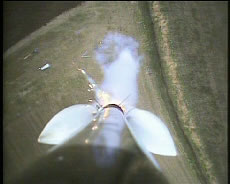 |
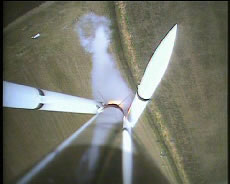 |
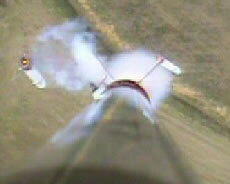 |
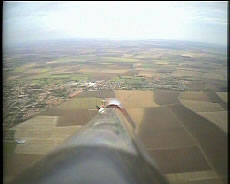 |
| The images in the sequence of frames above, are from onboard the MARS Phobos-V rocket, and show the separation of the strap-on boosters on the ascent, and the view just before the recovery system was inititated - the CCD colour video camera, transmitter and 12 volt rechargeable battery pack for this flight, cost a total of less than £200 | |
Like a number of others in the British Rocketry Community, I am keen on flying onboard rocket video cameras. The first system I used had a small CMOS black and white video camera ripped out of a toy video camera, and hooked up to the recording system.
My current rocket oboard video camera system uses a 21mm diameter, 1/3" CCD, 480 line bullet colour video camera from RF Concepts (Model Number: 21CWSHRX) which has significantly increased resolution and general performance, over cheaper models. The bulletcam runs off 12 volts, and draws a current of 130 miliAmps. As to whether or not it is worth paying extra for the increased resolution of a bulletcam like this, it largely depends on the intended application. If you never need more than low quality web style video, then you wouldn't need a camera like this, but if you would like to display footage at a larger size, and with a sharper image / better resolution, then it is well worth the money.
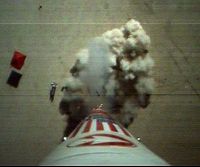 |
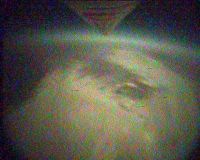 |
| The images above are still frame grabs from an onboard video system onboard the MARS Deimos-Odyssey rocket in the Black Rock Desert, Nevada, in 2002 - the CCD colour video camera and transmitter cost a total of less than £100 | |
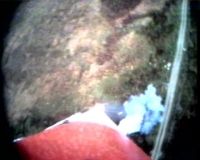 |
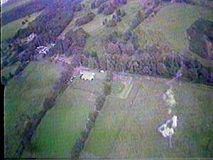 |
| The images above are still frame grabs from onboard video systems onboard a rocket launched in Scotland in 2001, and onboard a launch at the International Rocket Weekend in Scotland in 1996 | |
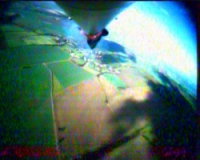 |
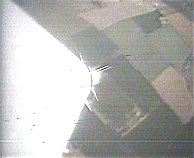 |
| The images above are still frame grabs from onboard video systems onboard a rocket launched in Cambridgeshire in 2002, and onboard a rocket in Lincolnshire in 2003 | |
FREQUENCIES
There are a number of frequencies which can be used for transmitting video in the U.K., these are 2.4 GHz (a licence free frequency band - also known as ISM band), 1.3 GHz (which requires a Test & Development Licence from the Radiocommunications Agency), and 433 MHz (which because of it's limited bandwidth. only supports black and white camera footage). The wavelengths for these frequency bands are as follows:
| Frequency | Wavelength |
|---|---|
| 2.4 GHz | 13cm |
| 1.3 GHz | 23cm |
| 433 MHz | 70cm |
The 2.4 GHz frequency is that used by video senders which are available in larger electrical retailers. Generally, these have an output transmission power of about 10 milliWatts. If one of these is to be used, in the U.K., you must not make any modification to the transmitter output power or to the transmitter antenna.
This may seem like a major disadvantage, but it actually isn't as bad as it may seem. The secret is in the receiver and the receiver antenna. The key is to ensure that a very sensitive receiver and an antenna with a good gain is used. For instance, some people have used Low Noise Blocks (LNBs) from satellite dishes to improve the received signal. Generally, at 2.4 GHz frequencies, a helical antenna is used for the receiver antenna.
RECORDING SYSTEMS
The footage received from onboard video camera telemetry systems can be connected to a number of different recording systems:
| Recording Method | Pros | Cons | |
|---|---|---|---|
| 1. | Connection to a video recorder back on the ground (to record the footage), and a TV monitor to view the video footage | Relatively Low Cost | Bulky Heavy |
| 2. | Connection to a DV camcorder (via an analogue in connection, or an analogue in adaptor to a DV-in connection) | Excellent Quality Footage Highly Compact & Portable System |
Expensive |
| 3. | Connection to a Laptop with an internal or external TV adaptor | Straight into a computer | Requires powerful CPU Expensive Quality unlikely to attain that of a DV camcorder |
Following recording of the footage, framegrabbing of individual video frames can be used to good effect for image analysis. This can result in subtle details being brought out of the images.
THE CAMERA FLIGHT SYSTEM
The following block diagram provides an idea of how a video telemetry system is constructed. There are few components - literally little more than CCTV camera, video transmitter, power supply and a few connectors and wires.
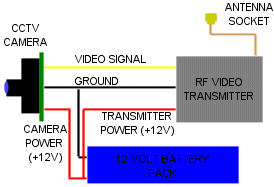
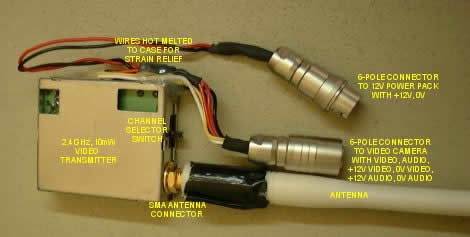
My system consists of an RF Concepts, 480 line 1/3" CCD Colour bulletcam, together with an external miniature microphone, and a 12 volt Nickel Metal Hydride (NiMH) radio control battery pack, made up from 2 x 6 volt, 1100 miliAmp hour, NiMH battery packs (which I charge from a Mascot benchtop power supply). The connectors I use are HRS/Hirose HR10 miniature 6-pole latching connectors from Farnell - they are not cheap, but as with anything connected with rocketry, it is often a false economy to go for the cheapest components, if they then break down during flight. The use of these connectors throughout the system, enables different video transmitters, power sources and cameras to be connected to the system - useful if any part of the system breaks down, since it is easy to unplug a unit, and connect a new unit.
The system is not cheap - including the CCD camera, external microphone, 12 volt NiMH battery pack, transmitter and the high quality miniature 6-pin connectors, it came to around £200. But then again, it provides a far high quality output than cheaper systems, and is a much more robust and flexible system, so in my mind, is worth paying extra to get the better quality components, and a higher chance of the system working during flight.
TIPS
1. Plan the system carefully. Draw out all connections first, label in what connectors are to be used, what type of wiring, and what the pinout arrangement on connectors will be.
2. Do not try and save money on cheap connectors. It really is a false economy. The advantage of decent connectors is robustness and reliability. There is a reason the professional space industry use decent quality connectors - you do not want connectors failing on multi million pound launchers.
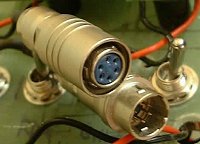
3. Pay special attention to the build quality of anything you construct. By far the major cause of system failures with video systems onboard rockets is poor quality construction. The most common areas of bad construction include:
- Bad soldering - dry joints, or poorly soldered links to connectors. There is nothing worse than turning up to a launch, powering one's system up, and then discovering intermittent problems, usually attributable to poor soldering.
- Use of insulation tape rather than heat shrink on connectors. This is a common mistake. Insulation tape lacks the "grip" that heat shrink provides, and consequently, increases the chance of any wires working themselves loose with lack of adequate strain relief.
4. Test the entire system before the day of the launch. Turning up to a launch with an untried, untested video system, is a recipe for disaster.
CAMERA RESOURCES
CCD and CMOS CCTV Colour video cameras are available in the U.K. from electronics suppliers such as RS, Farnell, Maplin Electronics, RF Concepts and Henry's. All of these do a whole range of CCD and CMOS video cameras (colour and black and white). Additionally, low cost security cameras are available from DIY stores, and these too can be used, although the image quality is generally not as good.
I settled on the RF Concepts bulletcams because they seemed to be cheaper than Farnell and RS, but offered better quality for the cheaper price. The Maplin and Henrys camera ranges don't seem to be so good at the higher resolution range any more, or at least from what I have seen.
High Resolution Option
| Component | Supplier | Part Number | Quantity | Cost (2005) |
| 480 TV Line, Panasonic CCD Bulletcam | RF Concepts www.rfconcepts.co.uk |
21CPH-B36 | 1 | £104.58 |
| Transmitter | Maplin www.maplin.co.uk |
DV68Y | 1 | £34.95 |
| 6 Volt, 1050mAh, NiMH Battery Pack (2 battery packs joined in series for 12V) |
www.modelpower.co.uk www.modelpower.co.uk |
Kan 6 Volt 1050mA 2/3A Flat RX | 2 | £23.90 (£11.95 each) |
| Onboard Camera Telemetry System Cost: | £163.43 | |||
Standard Resolution Option
| Component | Supplier | Part Number | Quantity | Cost (2005) |
| 380 TV Line, CCD Boardcam | RF Concepts www.rfconcepts.co.uk |
32CA | 1 | £69.33 |
| Transmitter | Maplin www.maplin.co.uk |
DV68Y | 1 | £34.95 |
| 6 Volt, 700mAh, NiCd Battery Pack (2 battery packs joined in series for 12V) |
www.modelpower.co.uk www.modelpower.co.uk |
Trapese 6 Volt 700mAh AA | 2 | £15.00 (£7.50 each) |
| Onboard Camera Telemetry System Cost: | £119.28 | |||
Useful Additional Components
| Component | Supplier | Part Number | Order Code | Quantity | Cost (2005) |
| Mascot NiMH/NiCd Battery Charger | Farnell www.farnell.co.uk |
8714 CC UK | 4226069 | 1 | £22.34 |
| 6-pole miniature socket | Farnell www.farnell.co.uk |
HR10-7R-6S HRS (HIROSE) |
147032 | 1 | £8.55 |
| 6-pole miniature free plug | Farnell www.farnell.co.uk |
HR10-7R-6P HRS (HIROSE) |
147030 | 1 | £12.27 |
TRANSMITTER/RECEIVER RESOURCES
Maplin Electronics sell video transmitters and recievers, including a small transmitter module suitable for fitting inside a small diameter rocket airframe (54mm / 2 inch diameter airframes). Other sources of transmitters and receivers include RS, Farnell and Bitz Technologies.
NOTES
As with the gimballed rocket and guidance web pages, please note if you need any more information, please try and be specific if you need to contact me. Unfortunately, I get deluged with email, and the only way to filter what I have time to answer (in the little time I do have), is to try and answer people with specific questions. I've unfortunately not generally got time to design whole systems for people, if I did that, then I'd never have time to test my own equipment and then write it up unfortunately!
All the sources that are needed for people to build sub £120 onboard video systems are available from the companies noted on this web page, so anyone asking "where can I get....?" is unlikely to get a reply, purely because my spare time is minimal, and I have to make the best use of it. I can't do everyone's homework, so those who want to work out their ideal system need to do some research. Like guidance, this is the type of technical project, that if you are not prepared to do at least a small amount of work (such as typing a company name or component into an online search), it will be hard to reap the rewards in terms of the stunning imagery that can be obtained.
DISCLAIMER
Note - It is against the law to transmit video signals at certain wavelengths in the U.K without the appropriate licence and permission. This web page does not in any way condone activities of this nature without such a licence.
See Also
Hybrid Rocket Science, Hybrid Rocket Help Clinic, Amateur Hybrid Motors, Amateur Liquid Rockets, Guidance, Gimballed Motors, Launch Controller, UK Rocketry Vendors, UK Rocket Groups, UK Space Organisations

